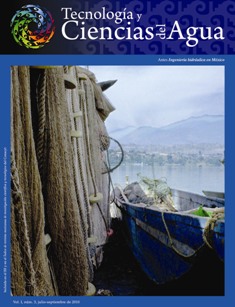Hydrogeology and hydrodynamic of the Gormaz Springs Aquifer and its importance to the base flow of the Duero River, Spain
DOI:
https://doi.org/10.24850/j-tyca-2010-03-01Keywords:
carbonate aquifer, base flow, spring, Duero River, SpainAbstract
In a short stretch of its headwaters, the base flow of the River Duero increases by several m3/s as it traverses some Mesozoic carbonate outcrops. This is of special importance during the dry season, when the majority of the base flow of the river proceeds from springs in this reach. The outcrops correspond to one of two confined calcareous aquifers that developed in parallel but which are not hydraulically connected because of an impermeable layer. Together, they constitute the aquifer system of the Gormaz Springs. The system is still in its natural regime and is hardly exploited. This study defines the conceptual model of hydrogeological functioning, taking into consideration the role of the Gormaz Fault, which is situated in the discharge zone of the system. Analysis of both antecedent geological information and geophysical explorations has led to a better understanding of the geometry and boundaries of the aquifers, defining an aquifer system with a recharge zone in the south corresponding to in the calcareous outcrops. These calcareous outcrops are confined to the north below Tertiary formations, as far as their intersection with the normal fault of Gormaz. The throw of the fault forms the barrier of the permeable formations situated in the extreme north (right bank of the River Duero). In turn, the fault plane facilitates the upflow of groundwater from the aquifer system and creates hydraulic connection between the two aquifers. In addition, the study estimated the hydraulic parameters of the aquifer around the fault. The close correlation between piezometric levels and the groundwater discharges to the River Duero has enabled the reconstruction of the hydrogram of Gormaz springs over the period 1992-2006. By this means, it is calculated that the groundwater contribution to the River Duero is 135.9 hm3/year, or 18.9% of the total river inflow.
References
BOND, J. Tectono-sedimentary evolution of the Almazan basin. NE Spain in Tertiary basins of Spain: the stratigraphic records of crustal kinematics. London: Cambridge University Press, 1996, pp. 203-213. DOI: 10.1017/CBO9780511524851.030
CASAS, A. and MAESTRO, A. Deflection of compressional stress field by large-scales basement faults. A case study from the Tertiary Almazan Basin (Spain). Tectonophysics. Vol. 255, 1996, pp. 135-156. DOI: 10.1016/0040-1951(95)00111-5
CASAS, A., CORTÉS, A. and MAESTRO, A. Intra-plate deformation and basin formation during the Tertiary at the northern Iberian plate: Origin an evolution of Almazan basin. Tectonics. Vol. 19, no. 2, 2000, pp. 258-289. DOI: 10.1029/1999TC900059
CHDUERO. Propuesta del Plan Hidrológico de la Cuenca del Duero. Memoria y Anejos. Valladolid: Confederación Hidrográfica del Duero, Ministerio de Obras Públicas, Dirección General de Obras Hidráulicas, 1995.
CRUCES DE ABIA, J. Evaluación de los recursos subterráneos. Las aguas subterráneas en el Libro Blanco del Agua en España - Actas de las jornadas celebradas en Madrid. Samper, J. y Llamas, M.R. (editores). Madrid: Asociación Internacional de Hidrogeólogos-Grupo Español, 1999.
CUSTODIO, E. y LLAMAS, M.R. Hidrología subterránea. Segunda edición. Vol. I y II. Barcelona: Ediciones Omega, 1983.
DGOH-SGOP. Estudio hidrogeológico de Soria. Anejo 4. Inventario de puntos de agua. Madrid: Dirección General de Obras Hidráulicas, Servicio Geológico de Obras Públicas, 1989.
DGOH. Estudio hidrogeológico de la Cubeta de Almazán (Soria). Segundo informe 2-884. Madrid: Dirección General de Obras Hidráulicas, Ministerio del Medio Ambiente. Inédito, 1995.
DGOH. Informe hidrogeológico: cuantificación del caudal de base del río Duero entre Andaluz y San Esteban de Gormaz, a partir de datos piezométricos. Núm. de informe 12. Dirección General de Obras Hidráulicas, Ministerio del Medio Ambiente. Inédito, Madrid, 1999.
IGME. Investigación hidrogeológica básica del sistema nº 88 (10bis)-Terciario del Sureste de Soria, Cuenca del Duero. Plan Nacional de Investigación de Aguas Subterráneas. Madrid: Instituto Geológico y Minero de España, 1983.
ITGE. Las aguas subterráneas en España (estudio de síntesis). Memoria. Madrid: Instituto Tecnológico y Geominero de España, 1989.
ITGE. Mapas geológicos 1/50000 nº 377 (Burgo de Osma), nº 378 (Quintana Redonda), nº 405 (Berlanza de Duero), nº 406 (Almazán) y nº 433 (Atienza). Madrid: Instituto Tecnológico y Geominero de España, 1991.
MAESTRO, A. Estructura y evolución alpina de la cuenca de Almazán (cordillera Ibérica). Tesis doctoral. Colección de Temas Sorianos núm. 48. Soria, España: Área de Geodinámica, Departamento de Geología, Universidad de Zaragoza, Excma. Diputación Provincial de Soria, España, 2004.
MORAL, F., CRUZ-SANJULIÁN, J. and OLÍAS, M. Geochemical evolution of groundwater in carbonate aquifers of Sierra Segura (Betic Cordillera, Southern Spain). Journal of Hydrology. Vol. 360, 2008, pp. 281-296. DOI: 10.1016/j.jhydrol.2008.07.012
PARK, E. and PARKER J.C. A simple model for water table fluctuation in response to precipitation. Journal of Hydrology. Vol. 356, 2008, pp. 344-349. DOI: 10.1016/j.jhydrol.2008.04.022
RODRÍGUEZ, J.A. Geomorfología de un sector de la cuenca de Almazán (Soria): procesos de erosión de suelos y planteamiento de escenarios ante el cambio climático. Tesis doctoral. Madrid: Facultad de Ciencias Geológicas, Universidad Complutense de Madrid, 2008.
SÁNCHEZ, A., SAHUN, B. y MENÉNDEZ, A. Conocimiento y predicción de caudales base de ríos procedentes de acuíferos inexplotados. Ejemplo del Duero entre Almazán y San Esteban de Gormaz. Boletín de Informaciones y Estudios nº 55. Madrid: Ministerio de Obras Públicas y Transportes, 2000, pp. 7-16.
SANZ, E. Las aguas subterráneas en Soria. Ediciones de la Exma. Soria, España: Diputación Provincial de Soria, 1999, 367 pp. DOI: 10.2307/jj.17381568.22
Downloads
Published
How to Cite
Issue
Section
License
Copyright (c) 2010 Tecnología y ciencias del agua

This work is licensed under a Creative Commons Attribution-NonCommercial-ShareAlike 4.0 International License.
By Instituto Mexicano de Tecnología del Agua is distributed under a Creative Commons Attribution-NonCommercial-ShareAlike 4.0 International License. Based on a work at https://www.revistatyca.org.mx/. Permissions beyond what is covered by this license can be found in Editorial Policy.









